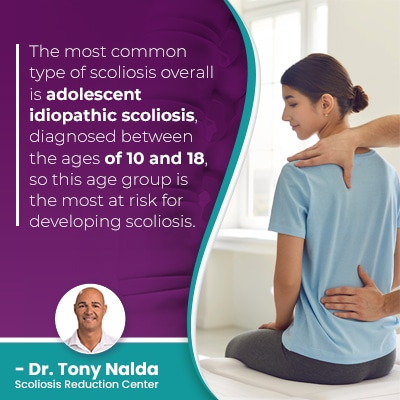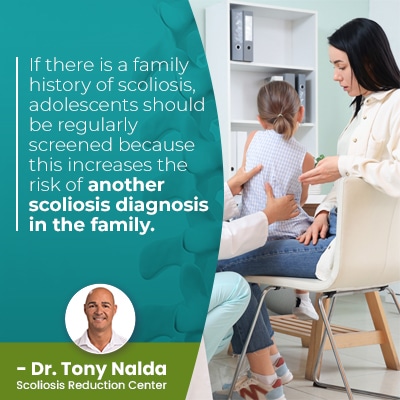What Are the Chances of Getting Scoliosis? Key Risk Factors

As the leading spinal deformity among school-aged children, scoliosis awareness is important. The age group most commonly diagnosed with scoliosis are adolescents between the ages of 10 and 18, and as a family history of scoliosis is considered a risk factor, if a family member has already been diagnosed, adolescents should be regularly screened.
Current estimates have close to seven million people living with scoliosis in the United States alone. Four out of 100 adolescents will be diagnosed with adolescent idiopathic scoliosis, and 30 percent of those patients have a family history of scoliosis.
Age, gender, and family history are all considered scoliosis risk factors, so let's explore each one.
Table of Contents
Age as a Scoliosis Risk Factor
Scoliosis causes the spine to develop an unnatural sideways curvature that also twists, and as a progressive condition, the nature of scoliosis is to get worse over time.
All ages can be affected by scoliosis from babies born with congenital scoliosis to infants between the ages of 6 months and 3 years old with infantile scoliosis, juveniles between 3 and 10 diagnosed with early-onset juvenile scoliosis, adolescent idiopathic scoliosis, and adult scoliosis is diagnosed once skeletal maturity has been reached.
 The most common type of scoliosis overall is adolescent idiopathic scoliosis, diagnosed between the ages of 10 and 18, so this age group is the most at risk for developing scoliosis.
The most common type of scoliosis overall is adolescent idiopathic scoliosis, diagnosed between the ages of 10 and 18, so this age group is the most at risk for developing scoliosis.
Idiopathic scoliosis has no known cause, but we do know what triggers scoliosis to progress: growth.
Considering the unpredictable and rapid growth spurts of puberty, it's clear why this age group is the most at risk for developing scoliosis and rapid curve progression.
The two main condition types to affect adults are idiopathic scoliosis and degenerative scoliosis, and the interesting thing is that while scoliosis is most often diagnosed during adolescence, the actual rate of scoliosis increases among the aging population, and this is due to spinal degeneration affecting older adults.
It's estimated that the actual rate of adolescent scoliosis is between 2 and 4 percent, while some studies looking at the prevalence of adults scoliosis have rates as high as between 12 and 20 percent, and in older adults over the age of 60, rates as high as 68 have been documented.
So natural age-related spinal degeneration increases the chances of being diagnosed with degenerative scoliosis.
As both adolescent scoliosis and degenerative scoliosis are more prevalent in females, gender can also be considered a scoliosis risk factor.
Gender as a Scoliosis Risk Factor
Female adolescents are not only more likely to be diagnosed with scoliosis than males of the same age.
The American Academy of Orthopaedic Surgeons estimates that female adolescents are 10 times more likely to develop adolescent scoliosis before the age of 10 than boys, and females are also approximately 10 times more likely to experience progression than males of the same age.
There are many theories attempting to explain why scoliosis is more prevalent in female adolescents than males from hormone levels to low body mass index and the earlier onset of puberty, but they remain just that: theories.
Age is also important because as growth spurts trigger progression, the younger a patient is, the more growth they have yet to go through, and by extension, the more potential progression they could be facing in the future.
Gender is also a risk factor for the development of degenerative scoliosis as females are more likely than males to be diagnosed, and this is related to hormone and bone density changes associated with menopause.
Genetic Factors and Scoliosis
If there is a family history of scoliosis, adolescents should be regularly screened because this increases the risk of another scoliosis diagnosis in the family.
Studies have found that a family history doesn't just increase the risk of another family member being diagnosed, larger curve sizes were found in patients with one or more additional family members with scoliosis.
While a lot of time and effort has been expended in the attempt to locate a scoliosis gene, or genetic combination, that accounts for the development of idiopathic scoliosis, one has yet to be identified; the higher prevalence of scoliosis in families is explained by the familial nature of the condition.
 Idiopathic means not clearly associated with a single-known cause, but that isn't the same as saying there is a complete absence of a cause.
Idiopathic means not clearly associated with a single-known cause, but that isn't the same as saying there is a complete absence of a cause.
Instead, scoliosis is thought to be multifactorial, meaning caused by a combination of factors that can vary from person to person, and remember, families share a lot more than just their genes.
Families share socioeconomic factors, geographical locations, diet, lifestyle, posture, responses to stress, and so much more, so any one of these factors, or a combination of them, could account for the development of scoliosis.
There have also been a number of twin studies conducted where one twin has scoliosis and the other doesn't, despite sharing the same genes, or where one twin has scoliosis and the other has a completely different type; these studies support that there are potential genetic factors that could play a role in both onset and severity, but this isn't the same as classifying a condition as genetic.
So while scoliosis isn't considered a hereditary spinal condition, family history is considered a significant risk factor that warrants the need for regular screening in children.
How is Scoliosis Diagnosed?
Scoliosis is diagnosed through a combined physical examination and the results of a scoliosis X-ray.
A physical examination will involve taking the patient's medical and family history to determine risk factors and examining the spine while in a forward bend position; the spine is the most visible in this position, as are any related trunk asymmetries.
The main effect of scoliosis in children involves postural changes as the condition's uneven forces disrupt the body's overall symmetry, and in many cases, the earliest signs of scoliosis include uneven shoulders and hips.
I also use a tool known as a Scoliometer to determine a patient's angle of trunk rotation (ATR).
If an Adam's forward bend test shows indicators of the condition, further testing in the form of an X-ray is warranted.
A scoliosis X-ray is needed to see what's really happening in and around the spine, to confirm the rotational component, and to determine the patient's Cobb angle measurement.
A minimum Cobb angle of 10 degrees is needed to be considered a true scoliosis, and the higher a patient's Cobb angle, the more severe the condition.
- Mild scoliosis: Cobb angle measurement of between 10 and 25 degrees
- Moderate scoliosis: Cobb angle measurement of between 25 and 40 degrees
- Severe scoliosis: Cobb angle measurement of 40+ degrees
- Very-severe scoliosis: Cobb angle measurement of 80+ degrees
Condition severity is determined by Cobb angle, and treatment plans are shaped around factors like severity, and while there are no treatment guarantees, an early diagnosis followed by early intervention
The most important decision to be made following a diagnosis is how to treat the condition because how a diagnosis is responded to will shape the spine's long-term health and function: a factor that shapes a patient's quality of life.
Scoliosis Treatment Options
There are two main ways to treat scoliosis: surgically and nonsurgically.
Surgical intervention is a common result of traditional scoliosis treatment, and conservative treatment offers a surgical alternative through a proactive approach.
Spinal fusion surgery is invasive and risky and can cost the spine in terms of its overall health, strength, and function.
A fused spine is one that's weaker and more vulnerable to injury and as fusing the spine is contrary to its movement-based design, it can cost the spine in terms of its overall flexibility and range of motion.
Conservative scoliosis treatment is integrative and combines different types of treatment so conditions can be impacted on every level.
As a structural spinal condition, the spine's structure has to be impacted, and this is worked towards through condition-specific chiropractic care that can realign the spine and restore as much of the spine's natural curves as possible.
As it's not just the spine that has to maintain its natural curves and alignment, but also the spine's surrounding muscles, physical therapy and scoliosis exercises can address muscle weakness, a muscular imbalance, and improve spinal support and stability through strength-building.
Physical therapy and exercise can also help prepare the spine and its surroundings for treatment.
Corrective bracing is a common facet of childhood scoliosis treatment and can help by pushing the spine into a straighter alignment.
Rehabilitation can involve continued chiropractic care, lifestyle guidance, and prescribed scoliosis specific exercises that can be performed from home to further heal and stabilize the spine.
Conclusion
The chances of getting scoliosis are highest for adolescent females and older females facing natural age-related spinal degeneration.
Risk factors for developing scoliosis include age, gender, and family history.
Adolescents are the most commonly diagnosed with the condition, Females are more likely than males to develop adolescent scoliosis and degenerative scoliosis, and females are also more likely to experience curve progression requiring treatment.
If a member of the family has scoliosis, this is considered a risk factor for other members developing the condition, and while there are genetic factors that are thought to contribute to the condition's onset, these factors are also familial; scoliosis isn't a heritable condition.
Scoliosis is highly prevalent, is the leading spinal condition among school-aged children, and gets worse over time, hence the benefit of a proactive treatment approach.
Proactive treatment is started as close to the time of diagnosis as possible in the interest of preventing progression, increasing condition effects, and the need for surgical intervention in the future.
When it comes to 80 percent of known scoliosis cases, the cause involves idiopathic scoliosis so is unknown, and the remaining 20 percent are associated with known causes: neuromuscular scoliosis, congenital scoliosis, and degenerative scoliosis.
While we don't always know why scoliosis develops initially, here at the Scoliosis Reduction Center®, we know how to treat it effectively and the first step is starting treating as close to the time of diagnosis as possible because as a progressive condition, the best time to start treatment is always now.
Dr. Tony Nalda
DOCTOR OF CHIROPRACTIC
After receiving an undergraduate degree in psychology and his Doctorate of Chiropractic from Life University, Dr. Nalda settled in Celebration, Florida and proceeded to build one of Central Florida’s most successful chiropractic clinics.
His experience with patients suffering from scoliosis, and the confusion and frustration they faced, led him to seek a specialty in scoliosis care. In 2006 he completed his Intensive Care Certification from CLEAR Institute, a leading scoliosis educational and certification center.
About Dr. Tony Nalda
 Ready to explore scoliosis treatment? Contact Us Now
Ready to explore scoliosis treatment? Contact Us Now





